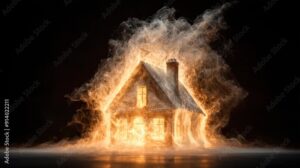Fire safety is an essential aspect of home life, especially for urban families living in densely populated areas. A well-thought-out fire escape plan can mean the difference between life and death when seconds count. Whether you own your home or are renting, being prepared can help ensure the safety of your loved ones. Here’s a comprehensive guide to creating an effective fire escape plan for your urban home.
Home Alarms || Fire, Flood, and Radon Alarms
https://youtu.be/YG9p5ePT5lk
Understanding the Importance of a Fire Escape Plan
Fires can spread rapidly, leaving just a few minutes to safely exit your home once the smoke alarm sounds. Having a fire escape plan ensures that everyone knows what to do and where to go during an emergency. It’s crucial for every family member, including children, to be familiar with the plan.
Step-by-Step Guide to Creating Your Fire Escape Plan
1. Assess Your Home Layout
- Identify Exits: Start by identifying all possible exits from each room, including windows and doors. Ensure that all exits are easily accessible and not blocked by furniture or other objects.
- Consider Altitude: For multi-story homes, consider how to safely evacuate from higher floors. Install escape ladders in upper-level rooms if necessary.
2. Establish Escape Routes
- Primary and Secondary Routes: Determine at least two exits from each room, a primary and a secondary route, in case the main path is blocked by fire.
- Clear and Safe Paths: Make sure all escape routes are clear and free from obstacles at all times. Test the routes to ensure they are safe and functional.
3. Designate a Meeting Spot
- Choose a Safe Location: Pick a safe location outside your home where everyone will meet after evacuating. This makes it easier to account for all family members once outside.
- Ensure Accessibility: The meeting spot should be easily accessible and far enough away from the house to avoid harm.
4. Install and Maintain Safety Equipment
- Smoke Alarms: Install smoke alarms in key areas of your home, such as kitchens, bedrooms, and hallways. Check them monthly to ensure they are working properly.
- Fire Extinguishers: Have fire extinguishers readily available and know how to use them. Place them in strategic locations like the kitchen and garage.
5. Practice Regular Drills
- Conduct Drills: Regularly practice your fire escape plan with your family. Drills help reinforce the plan and ensure everyone knows what to do in an emergency.
- Simulate Scenarios: Practice different scenarios, such as blocked exits or nighttime evacuations, to prepare for various situations.
6. Educate and Involve Everyone
- Involve All Family Members: Ensure everyone in the household, including children, understands the fire escape plan. Educate them about fire safety and the importance of remaining calm during an emergency.
- Review Annually: Revisit the escape plan annually or whenever there are significant changes in the household layout.
Conclusion
Creating a fire escape plan is a crucial step in ensuring the safety of your family in the event of a fire. By assessing your home, establishing clear escape routes, installing safety equipment, and conducting regular drills, you can prepare yourself and your loved ones to act quickly and effectively during an emergency. Don’t wait until it’s too late—take action today to safeguard your urban home and family.
For more safety tips and resources, visit our blog or contact local fire safety experts to help you further enhance your fire readiness. Stay safe!
Additional Tips for Urban Fire Safety
In addition to creating a fire escape plan, there are several other steps you can take to prevent fires and increase safety in your urban home.
- Smoke Detectors: While smoke alarms are essential, interconnected smoke detectors that sound an alarm throughout the house when one is triggered can provide even more protection.
- Electrical Safety: Be mindful of using multiple power strips and extension cords, which can overload circuits and potentially cause a fire. Regularly check electrical outlets for any signs of damage or wear.
- Cooking Safety: Unattended cooking is the leading cause of home fires. When cooking, stay in the kitchen and keep flammable items.
For Tons of Great Free Information please hit “Like & Subscribe”
Websiteconstructionconsumeradvocacyinstitute.com
Podcastanchor.fm/galloway
www.youtube.com/@ConstructionConsumerAdvocacy






